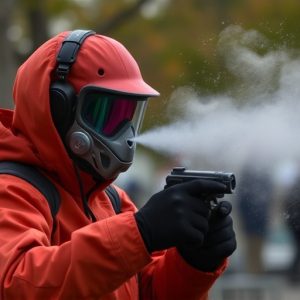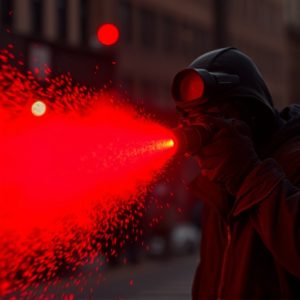Peering into Pepper Spray: Comprehensive Guide on Its Effects and Legal Use in Self-Defense
Pepper spray is a non-lethal self-defense tool that uses oleoresin capsicum (OC) to temporarily inc…….
Pepper spray is a non-lethal self-defense tool that uses oleoresin capsicum (OC) to temporarily incapacitate attackers by causing intense pain and irritation to the eyes, skin, and respiratory system. Its effects include temporary blindness, breathing difficulties, and a burning sensation that can last up to 45 minutes, providing an opportunity for escape or law enforcement intervention. Despite its potency, pepper spray is designed not to cause permanent harm, and its effects can be mitigated with water and airflow. It's legal in many jurisdictions, but it's crucial to understand both the proper use of pepper spray and the local laws governing its deployment to ensure responsible use. The question "Can pepper spray blind you?" is valid; while it can cause temporary vision loss, it does not lead to permanent blindness. Proper understanding and application are key to safely using pepper spray as part of a comprehensive self-defense strategy, addressing concerns about its effects and legalities.
When it comes to personal safety, non-lethal defense options like pepper spray have become increasingly popular. Known for its potent incapacitating effects, pepper spray is a tool that can effectively deter attackers without causing permanent harm. This article delves into the mechanics of pepper spray, addressing concerns such as “Can pepper spray blind you?” and its role in self-defense scenarios. We’ll explore how this defensive measure works, its safety and efficacy, and the legal nuances surrounding its use. Understanding these aspects is crucial for anyone considering pepper spray as a means to protect themselves.
Understanding Pepper Spray: Its Effects and Usage in Non-Lethal Defense
Pepper spray, a widely recognized non-lethal defense mechanism, is an effective deterrent against potential assailants. It contains a highly irritant compound known as oleoresin capsicum (OC), which induces intense pain upon contact with the mucous membranes of the eyes, skin, and respiratory tract. The effects are both immediate and debilitating, causing a burning sensation, temporary blindness, and difficulty in breathing. This incapacitates an attacker without causing permanent harm or fatalities. It’s often employed by law enforcement officers and civilians alike for personal safety due to its effectiveness in deterring violence. The effects can last from 30 to 45 minutes, allowing time for a safe escape or for authorities to intervene. Understanding the potential of pepper spray to temporarily blind an individual is crucial for recognizing its role in non-lethal defense strategies. Users should be well-versed in its application techniques and legal considerations, ensuring its use is justified and within the bounds of the law.
The Mechanism Behind Pepper Spray: How It Temporarily Disables Assailants
Pepper spray, a widely recognized non-lethal defense mechanism, is an effective tool for self-protection against assailants. The substance at the core of its effectiveness is oleoresin capsicum (OC), a blend derived from hot chili peppers. When deployed, pepper spray causes intense irritation to the eyes, skin, and respiratory system of an assailant. Upon contact with the eyes, the capsaicin in the spray binds with sensory neurons, sending a signal to the brain that interprets as pain, leading to involuntary spasms and temporary blindness. This reaction can last from 15 to 45 minutes, giving the victim valuable time to escape or for law enforcement to intervene. It’s often questioned whether pepper spray can permanently blind someone; however, while it can cause a loss of vision ranging from temporary to several hours, permanent blindness is rare. The effects are concentrated and reversible upon washing with water and exposure to wind or airflow that helps dilute the chemical. Understanding the mechanism behind pepper spray is crucial for its proper use in self-defense scenarios, ensuring that it serves as a non-lethal deterrent rather than causing irreversible harm.
Evaluating the Safety and Efficacy of Pepper Spray as a Self-Defense Tool
Pepper spray, a commonly used non-lethal self-defense tool, is an effective deterrent against assailants due to its incapacitating effects. The active ingredient in pepper spray, OC (oleoresin capsicum), triggers a strong irritant reaction upon contact with the eyes, face, or skin. This reaction can cause immediate pain, inflammation, and temporary blindness, often referred to as ‘flash-blindness,’ which can disorient an attacker and provide the user with a critical escape opportunity. The effects are typically short-lived, lasting from 15 to 45 minutes, but they are potent enough to end a confrontation without causing long-term harm. It’s important to note that while pepper spray can indeed cause temporary blindness, its use must be appropriate and targeted away from the wind to avoid accidental exposure to bystanders. The safety and efficacy of pepper spray are well-documented; it is legal in most jurisdictions and widely recognized as a viable option for personal defense. Users should familiarize themselves with local regulations and proper usage techniques to ensure their safety and the safety of others when employing this tool.
Legal Considerations and Best Practices for Using Pepper Spray in Self-Defense Situations
When considering non-lethal defense options, such as pepper spray, it’s crucial to understand both its effectiveness and the legal framework governing its use. Pepper spray, a form of OC (Oleoresin Capsicum) spray, is designed to temporarily incapacitate an assailant by causing irritation to their eyes, skin, and respiratory system. Its ability to cause pain and impaired vision without causing permanent harm makes it a popular choice for personal defense. However, the use of pepper spray in self-defense situations is subject to legal restrictions in many jurisdictions. Users must familiarize themselves with state or local laws that dictate where and how pepper spray can be carried and deployed.
Best practices for using pepper spray responsibly include knowing the specific laws that apply to your area, understanding the proper techniques for aiming and deploying the spray effectively, and being aware of the potential collateral effects on bystanders or pets. It’s also important to recognize that while pepper spray can be an effective deterrent, it is not a guaranteed solution. Users should consider training in self-defense and situational awareness as complementary measures to enhance personal safety. Additionally, always ensure that the pepper spray product you choose complies with local laws, including its strength and formulation. By adhering to legal guidelines and employing pepper spray as part of a broader personal security strategy, individuals can better protect themselves while respecting the rights and well-being of others.


